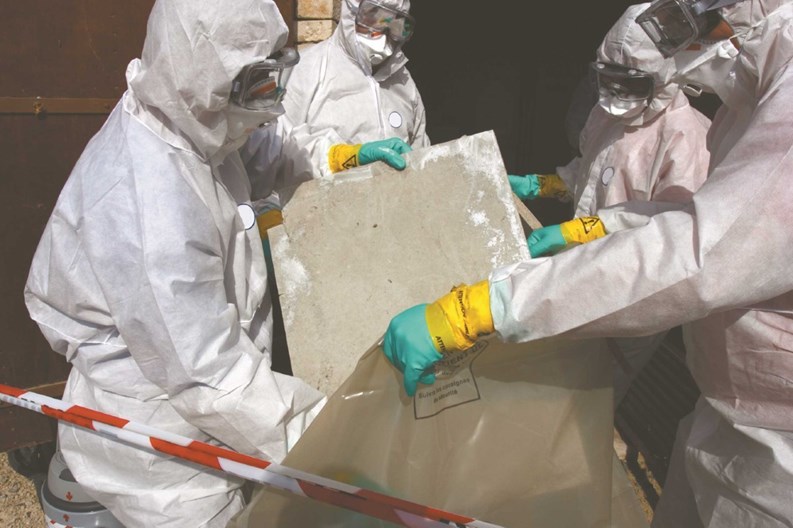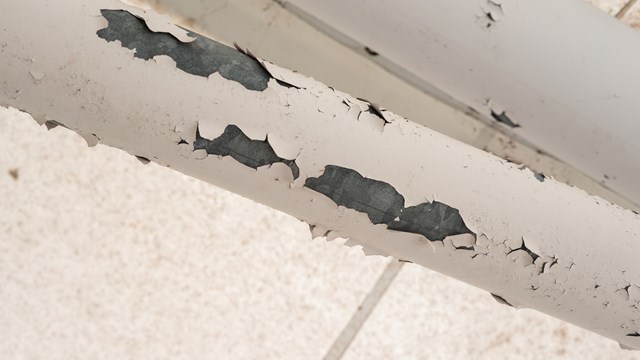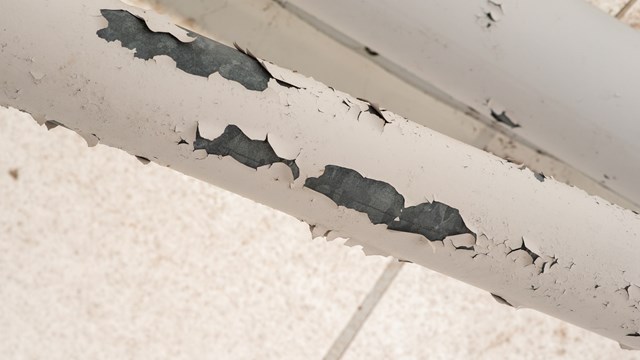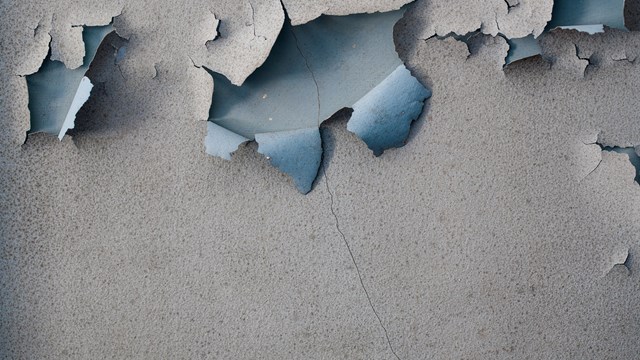Our homes are our sanctuaries—the places we go to feel safe. Sometimes, though, problems arise that can threaten that sense of security. We worry about fire, or intruders or other common fears, but rarely do we consider environmental contaminants, the things that may be in our walls or basements or even the air. Thankfully though, there are ways to deal with those issues and restore that sense of security to the places we call home. Of all the semi-invisible problems that can plague a multi-family residential building, the three most common are lead paint, asbestos and mold. Whether those problems may be present within a building depends on the building itself, however.
“How old is it? What life cycle point is it at?” asks Charles Schwartz, owner and principal consultant of Environmental Assessments & Solutions, Inc. in Brooklyn. “Older buildings may have asbestos and lead that can be of concern,” Schwartz says. But new federal rules on lead paint removal during renovations now must be taken into consideration.
Beginning in April 2010, federal law will require that any contractor that performs renovations, repairs and painting projects that disturb lead-based paint in homes, child care facilities, and schools built before 1978 must be certified and follow specific work practices to prevent lead contamination. This law will apply to single-family homes, as well as multi-family cooperatives and condominiums.
The Big Three
So why do things like lead and asbestos exist in the city’s buildings at all? In short, because they were thought to be effective and safe building materials at the time of their use. “Lead was a good paint,” says Josh Sarett of Manhattan-based ALC Environmental, which specializes in environmental remediation. “It was durable, it had a good shine and a good finish.” It wasn’t until later that people realized that peeling lead paint was poisonous, and posed particular risk to small children.
Asbestos, which was used for fireproofing as far back as the Greek and Roman eras, has long been used in manufacturing and building because of its seemingly indestructible nature. The word “asbestos,” in fact, comes from a Greek word meaning “inextinguishable” or “indestructible.” Because it proved so useful, people ignored or overlooked the health hazards associated with it—ranging from respiratory irritation to cancer. Not until the 1970s did the Environmental Protection Agency (EPA) and Occupational Safety and Health Administration (OSHA) begin regulating its use.
While both lead and asbestos are potential problems that plague some older buildings, issues of mold can form anywhere and anytime. Mold follows moisture, so anytime there is a flood, or a leaking roof, or water-entry anywhere involving a buildings’ windows, walls or foundation, there is the potential for mold growth. “Much of mold is hidden,” says Schwartz. “So you might not even know a mold problem is happening.” There are, however, tell-tale signs. “Usually a tenant will suspect a problem because of odors, stains or deterioration,” Schwartz says. When those types of problems recur or continue for long periods of time, that might be the sign to call in the experts.
Don’t Panic!
While things like asbestos, lead and mold may sound scary, they don’t have to be. Today there are a myriad of ways to handle all three problems, many of which involve little if any disruption for residents.
In the case of asbestos, removal of the material is not necessary unless it might be disturbed in the process of new construction or renovations. “Asbestos is only a problem when it becomes powder or dust and you breathe it,” says Frank Torre, a realtor and home inspector based in Hicksville.
In fact, if your building is considering renovations, “You have to prove to the city that any asbestos that is present won’t be disturbed,” adds Schwartz. That involves getting a permit verifying that claim. If the builder cannot prove that the material will remain undisturbed, then they must have the material removed—and there's a very specific process by which that must be done.
“You have to have a licensed asbestos removal company handle that,” Torre says.
During the professional removal process, a licensed consultant is required to be on-site to perform periodic air testing, and must come back afterward the job is done to conduct further testing and ensure the area is safe and meets air quality standards, says Schwartz.
Sarett concurs, adding that it's vital “to make sure you’re using an established firm that has good references, and is licensed, insured and bonded,” Sarett says.
With lead paint, if a resident or building manager suspects its presence in places where it might pose a danger to children or pregnant women—windowsills, ceilings, etc.—they may request testing. Also, if an apartment gets renovated and there is suspicion of lead paint it has to be tested. It’s also important to determine where the lead paint is located. “Is it just on a wall, or on a friction or impact surface?” Sarett says. “If it’s on a door jamb, it could create dust when the door opens or closes.”
If lead is suspected to be a threat to the resident, then it’s time to determine the exact nature of the problem. “Special samples will be taken and air tests conducted,” says Torre. “Those tests are then required by law to be sent to an independent laboratory.”
If lead paint is found, “You can remove and replace the components,” says Sarett. “You can chemically strip the paint or put sheet rock over the areas and cover them up.” When the process is complete, follow-up checks take place. “With lead, you take dust wipes at the end and do a visual inspection to make sure it’s meeting the local, state and federal guidelines.” The new laws require that an EPA-certified lead paint specialist be called in to inspect and conduct testing.
When it comes to mold, the professionals agree that the best way to take care of that issue is to stop it before it ever starts, which means handling leaks and water problems quickly and effectively. It also means making sure that proper venting and air flow is in place. Torre says he’s seen buildings where there are no dryer vents, “So it takes two hours to dry a load of clothes—and that causes unwanted moisture in apartments.” That excess, in turn, can cause mold.
If a mold problem exists, licensed specialists must be brought in to manage its removal but more importantly, crews must find the root of the moisture problem and fix that as well. Otherwise, it's probably only a matter of time before the mold crops up again.
While a wholesale asbestos or mold remediation project may be launched on a building-wide scale, it doesn't necessarily have to impact residents. Exceptions include finding asbestos in a resident’s actual unit. In that case, the resident will have to leave their home until the work is completed. With lead paint, unless a poisoning has occurred on the premises, then usually the resident can stay in the unit while the removal or fix takes place. With mold, it depends on how large the leak repairs are and how long they will take.
Other Things to Keep You Awake
The trio of environmental worries described above comprise the most common types of problems for New York co-op and condo residents. Other problems can arise as well however, including radon, which comes from decomposing gases in bedrock and can cause lung cancer and other breathing issues, according to Torre. The EPA reports that 20,000 people die annually from diseases caused by potential radon exposure. Radon, however, is not usually an issue for residents in high rises, as the gas is most often found in basements and other low-lying areas of the building. Because of that, says Schwartz, “New York City does not require testing for it.”
Leaking oil tanks can be the source of other environmental headaches for building managers and boards. “Tanks are required to be tested periodically to ensure that they’re not leaking,” says Schwartz. If leaks are discovered in an outdoor tank, then the tank is usually pulled and the soil surrounding it must be cleaned up. For indoor tanks, the only difference is that less soil might have to be removed. “The regulations are especially stringent if oil migrates off site,” says Schwartz.
Getting it Done
Taking care of environmental issues can be pricey for a building. For contracting experts, the cost can run from $400 to tens of thousands of dollars if, for example, there is a lengthy asbestos removal project which requires the presence of an on-site expert. Repairs themselves can start around $3,000 and then again, rise into the tens of thousands for abatements.
Although many buildings will proactively take care of environmental issues, setting aside time and resources to tackle trouble spots before they erupt into something bigger, what happens if a building decides to put off fixing a problem? Often it comes down to a resident lodging a complaint with the city and violations being issued by the Department of Housing Preservation and Development (HPD). And if those violations are not remedied, the effects can be substantial: buildings with HPD violations cannot refinance or sell without clearing the problems, says Schwartz.
Ultimately, though, it’s in everyone’s best interest to respond quickly and effectively to environmental concerns. It’s the only way to ensure we all breathe easy.
Liz Lent is a freelance writer and a frequent contributor toThe Cooperator.










Leave a Comment